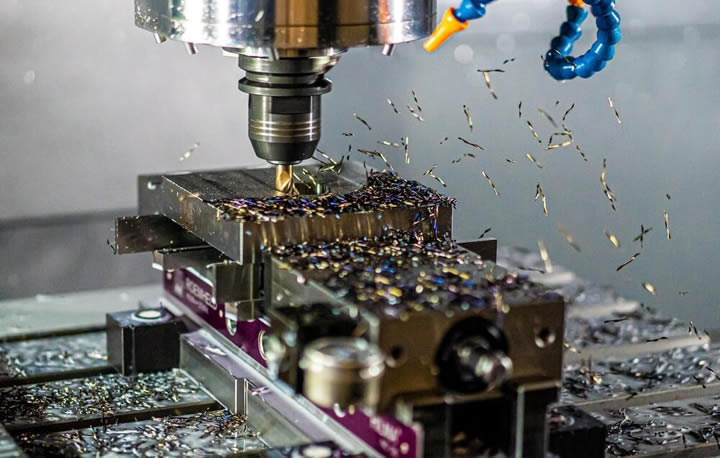When it comes to the manufacturing of components for airplanes or other structures associated with them, one of the most important things to keep in mind is the importance of certainty.
Any defects or inconsistencies could have catastrophic effects, ranging from the smallest component found inside the aircraft to the exterior of the craft. These effects could be caused by anything from a missing screw to a faulty electrical connection.
Because it is able to achieve the extremely high levels of precision that are required in this sector, CNC machining is an appropriate production method for use in the aerospace industry. Citation needed Citation neededThis method's primary purpose is to provide users with the opportunity to achieve extremely precise tolerances. As a consequence of this, it offers powerful resolutions and guarantees the correct operation of the aircraft by making use of dependable components made of both metal and plastic.
What, exactly, is meant by the term "aerospace CNC Machining"?
Components for aircraft and space shuttles are manufactured through a process known as Aerospace CNC machining. These components are then used in the assembly and maintenance of the aircraft and space shuttles. It makes use of kits, components, and assemblies, all of which are important aspects of the manufacturing process that is used in the aerospace industry. This is done to ensure that the components of the aircraft are made of high-quality material, which is necessary for the components to be able to carry out their jobs in a secure manner.
Recent Advances in Aerospace Computer Numerical Controlled Machining Technologies
Since a significant number of years ago, the worldwide aerospace industry has been at the forefront of the race to develop exceptional and innovative manufacturing technologies. Because of the increased breadth of technological possibilities, there has been a precipitous rise in the demand for components that have been machined. Aerospace CNC machining has become one of the manufacturing processes that is utilized in the field of aerospace engineering, making it one of the most prominent examples of this type of technology. When it comes to all aspects of their work, those in the aerospace industry place an extremely high premium on precision and accuracy. It only takes one mistake or a faulty component for a spacecraft or space station to rack up thousands of dollars in repair costs and put their lives in grave danger.
Machining done with computer numerical control (CNC), which is used in the production of components for aerospace vehicles.
Even if a person is not familiar with the CNC machining practices used in the aerospace industry, there are a few key points that illustrate how it operates and what the primary uses for it are in the industry, including the following:
1. Compositions of Materials Comprised of Light Metals
Aluminum and titanium are the two metals that are utilized in the aerospace industry the most frequently due to their incredible strength and lightweight properties, respectively. They are lighter than steel and other metals, which helps the aircraft improve its fuel consumption as well as its overall performance because of the aircraft's ability to carry more fuel.
2. In all facets of the economy, research and development make up an essential part of the production process, and computer numerical control (CNC) machining is at the forefront of the rapid prototyping phase.
Thanks to 3D CAD models that direct CNC machines to manufacture parts, aerospace engineers can now rapidly develop, test, and edit new prototypes while working in real-time. This is made possible by the fact that they can now work in real-time. Because it eliminates the requirement for an up-front investment in tools and reduces overall expenses, the utilization of CNC rapid prototyping is a cost-effective solution for aerospace companies. Additionally, it makes it simpler for aerospace companies to comply with regulatory requirements such as the AS 9001 and ISO 9001: 2015 quality standards. This is a significant benefit for the aerospace industry.
3. Production that requires complex building and layout techniques
In terms of their construction, the components that are used in aerospace vehicles are becoming an increasingly difficult challenge. With the assistance of 5-axis CNC milling machines, even the most complicated components are capable of being manufactured in order to satisfy these requirements.
4. CNC milling with the assistance of artificial intelligence
The most up-to-date computer numerical control (CNC) machines used in the aerospace industry come equipped with both artificial intelligence (AI) and machine learning software. Because of this combination, companies that specialize in aerospace are now able to accurately identify manufacturing indicators and achieve their targets for the manufacturing of aerospace components in a way that is simple and streamlined. As a direct consequence of this, enhancements can be made to the quality of machined aerospace components while also increasing their level of durability.
5. Preciseness
When it comes to purchasing a wide range of components, the aerospace industry is reliant on the production capabilities of independent manufacturers. Because of the tight tolerances on these components, it is imperative that they are fully compatible with the various other parts in the workshop. When using CNC machining of the highest precision, aerospace companies are able to manufacture components with the utmost attention to detail, achieve tolerances of up to 4 micrometers, and meet all of the specifications that were given to them. Machining by computer numerical control (CNC) offers an unparalleled level of accuracy, which is essential in a sector where it is not tolerated for components to malfunction while they are being used by customers.


